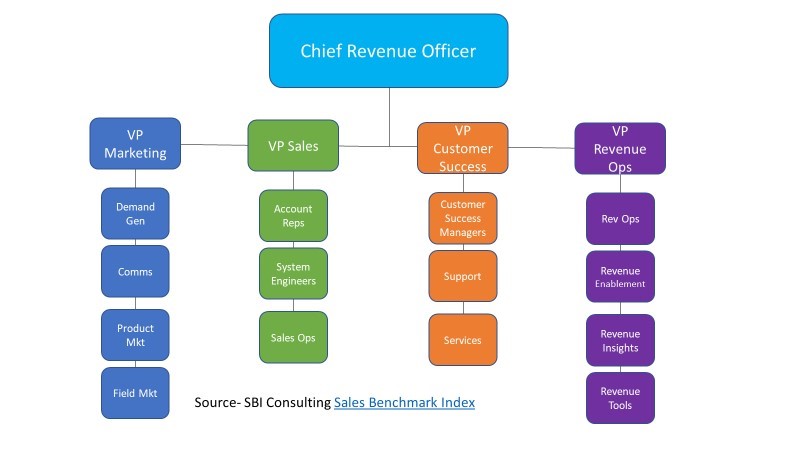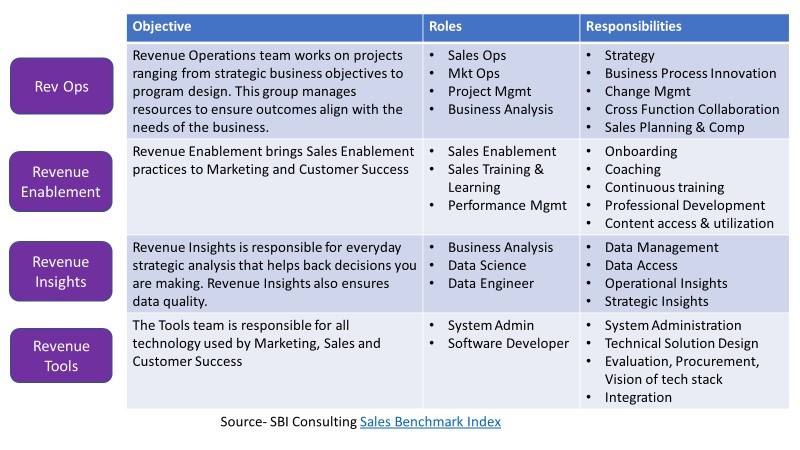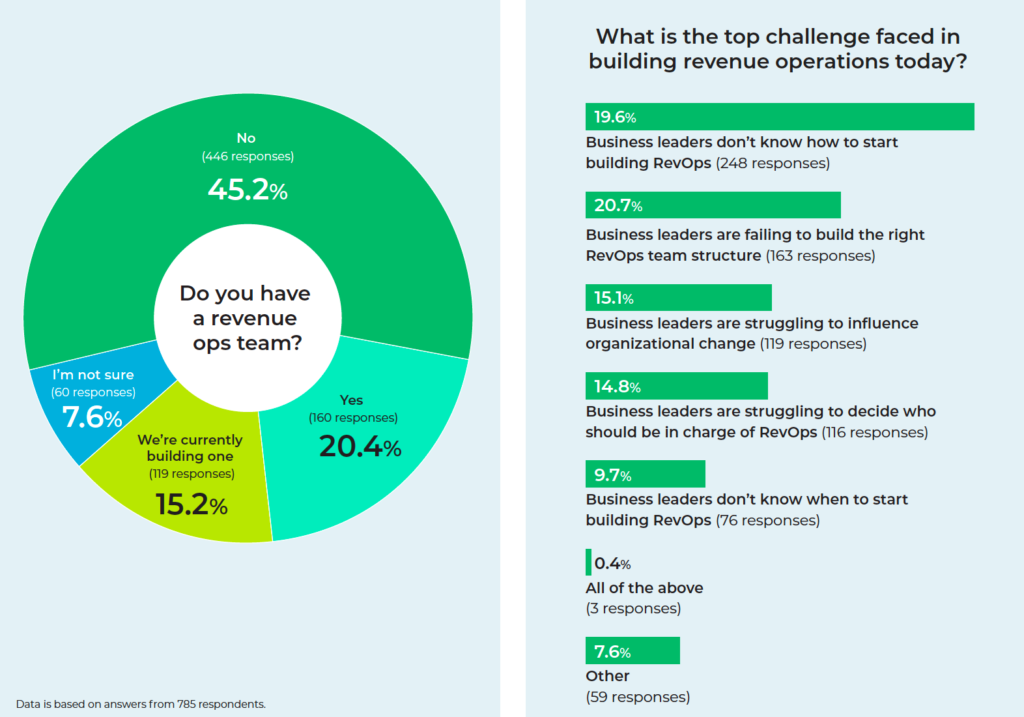Cover Photo Source- Courtesy Cerius Executives
Last week, Blackberry, in their quarterly earnings call, announced that CFO Steve Capelli was taking on a new role of Chief Revenue Officer. The announcement did the preempt the stock plunge.
We live in the era of fancy titles: Chief Amazement Officer, Chief Cheerleader and Chief Experience Officer; what do they really mean? Do these roles have P&L responsibilities or just sound fancy to attract attention. I decided to research this topic and educate my network.
What is a Chief Revenue Officer (CRO)?
A Chief Revenue Officer is accountable for driving all the company’s revenue growth as well as lead the Marketing, Sales and Customer Success (Support & Services), who are essentially the customer facing teams.
In most organizations, these functions are siloed and their heads don’t report to a single leader.
You hear the common stories where Sales blames Marketing for generating lots of poor-quality leads and Marketing responds that Sales does not know how to close deals.
Then there are the Customer Success team that fails to interact with Marketing. Organizations talk about customer focus but fail to operationalize it.
The Chief Revenue Officer addresses the communication gaps and alignment issues. CRO needs to be strategic- big picture and the lieutenants- Sales and Marketing heads are focused on execution.
The CRO has the holistic bird’s eye from the lead generation to pipeline, from win to support, from renewal to retention. They are responsible for having consistent messaging without bias throughout the customer life cycle.
Evolution of CRO
The Chief Revenue Officers sounds very similar to the Chief Operating Officer/ President role but there is a difference.
The traditional COO/ President role is responsible for all areas of operations that includes production, marketing and sales, and research and development. They may be an executor, mentor, change agent, partner or next in line of succession to the CEO.
In the Digital era, buyers increasingly measure the value of products and services not just by features and benefits, but by the ease of use and every touchpoint experience associated with buying and using the product or service.
Competitors catch up quickly with product features- say for example- phone camera wars among Apple, Google and Samsung. This type of commoditized similarity makes it difficult for marketers to differentiate. All products are faster, eco-friendly and efficient.
Today’s consumers and business buyers have more choices and higher expectations than ever before. They may not care about what makes your product functionally superior, but they care about how it improves their lives.
They want companies to be more human: to remember who they are, know what they like, and use that understanding to help them fulfill their needs.
They also expect companies to know about previous interactions and inquiries, without having to repeat details over the course of multiple interactions.
This requires high level of integration and coordination across every business unit, from sales and marketing to customer service, and across physical and digital channels.
This poses a deep challenge to companies organized by product and function rather than a customer-centric model like experience and value.
Historically, marketing has been in charge of customer engagement but many of the most vital points of interaction today are often not owned by marketing. It is essential for tighter collaboration and integration with support and customer success.
Over the years, there has been considerable strides in the business process like lean Six Sigma for supply chain but not revenue growth management process has been inefficient and unaddressed.
Leaders are often faced making the trade-offs across whether you need to add more reps, partners, pipeline, and/or PR across each business segment?
It is essentially that is leader thinks of these issues holistically with data driven information and that is the role of CRO.
The CRO role started in Silicon Valley based SaaS companies but now it has moved to mainstream companies like Coca- Cola and WalMart, placing the customer experience at the center of their transformation.
Rise of Revenue Operations
No CRO can be successful without having a Revenue Operations team.
Revenue operations (RevOps) is the strategic integration of sales, marketing and customer success departments to provide a better end-to-end view to administration and management, while leaving day-to-day processes within the departments. The holistic approach of revenue ops is designed to break down silos between departments. (Source- Techtarget)
So where does Revenue Operations team resides in the CRO organization? It resides under the CRO under the VP- Revenue Operations.

SBI Consulting (Sales Benchmark Index) has come up with framework for objective, roles and responsibilities for Revenue Ops team.

In the State of Revenue Ops 2018 Report, LeanData and Sales Hacker surveyed nearly 800 sales and marketing leaders from various industries. The survey shed light on how their respective organizations perceive, adopt, and implement Revenue Operations.
Some of the interesting findings were that nearly 56% do not have Revenue Operations teams and business leaders are having organizational design challenges.

What does it need to take to succeed as a CRO?
The ideal Chief Revenue Officer should have a multifaceted background in Sales, Marketing and Customer Success. Most of the Chief Revenue Officers evolve from either Marketing or Sales in reality.
We live in the world of specialists. Recruiting is based on what you have done and not want you can do? Most job descriptions require 2, 5, 10 years of experience in a specific function and rarely do you see multiple functions experience required.
In his research for his book Range- Why Generalist Thrive in Specialized World, David Epstein examined the world’s most successful athletes, artists, musicians, inventors, forecasters and scientists.
He discovered that in most fields—especially those that are complex and unpredictable- generalists, not specialists, are primed to excel.
Generalists often find their path late, and they juggle many interests rather than focusing on one. They’re also more creative, more agile, and able to make connections their more specialized peers can’t see.
This is contradictory to Malcolm Gladwell’s 10,000 hour rule; the key to success in any field, is simply a matter of practicing a specific task that can be accomplished with 20 hours of work a week for 10 years.
Here is Malcolm Gladwell’s quote about the book
“For reasons I cannot explain, David Epstein manages to make me thoroughly enjoy the experience of being told that everything I thought about something was wrong. I loved Range.”
— Malcolm Gladwell, bestselling author of Blink and Outliers
CONCLUSION
Revenue Operations is still in its infancy and it will take time for organizations to test and evolve. There is an imperative need to break the silos, have better cross functional alignment and holistically track revenue generation metrics throughout the customer lifecycle.
It is essential that companies have rotational programs whereby they move employees within Sales, Marketing and Customer Success teams so that they have the opportunity to wear multiple hats.
You
may be surprised why Blackberry chose their CFO to become their next CRO? It
turns out Steve Capelli prior to joining BlackBerry as CFO, was President of
Worldwide Field Operations at Sybase with responsibility for more than $1
billion in annual revenue.
Steve also led international operations at Sybase as General Manager with
responsibility for sales, operations, finance, customer support, marketing and
human resources.
PS- If you are a sports enthusiast and big fan of Roger Federer, view this six-minute video of the conversation between Daniel Epstein and Malcolm Gladwell.
References-


